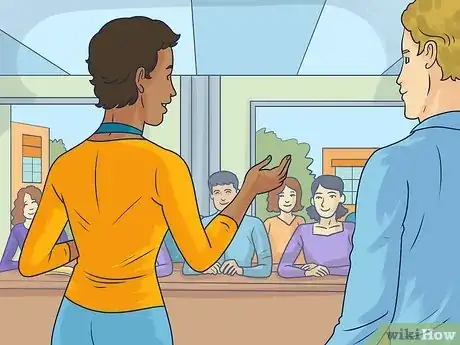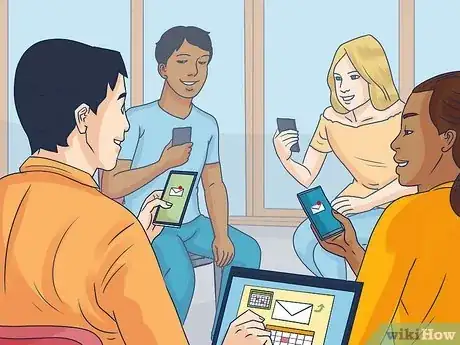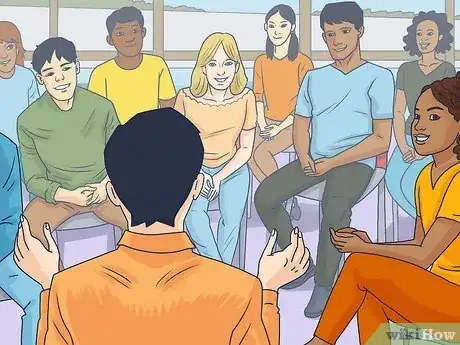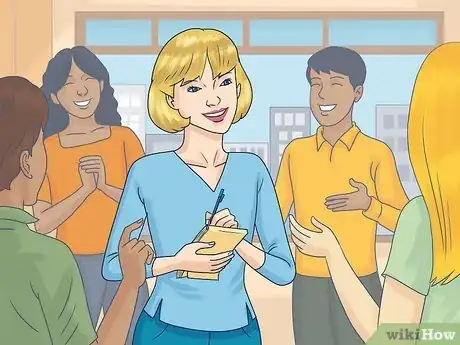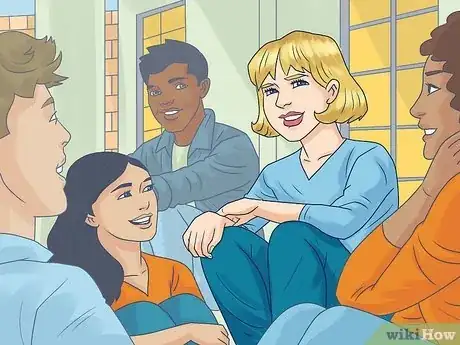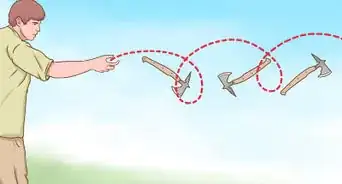wikiHow is a “wiki,” similar to Wikipedia, which means that many of our articles are co-written by multiple authors. To create this article, 10 people, some anonymous, worked to edit and improve it over time.
There are 8 references cited in this article, which can be found at the bottom of the page.
wikiHow marks an article as reader-approved once it receives enough positive feedback. In this case, 100% of readers who voted found the article helpful, earning it our reader-approved status.
This article has been viewed 54,708 times.
Learn more...
Do you have a passion that you’d like to explore more? Maybe starting a group with others who share the same interest would be a good way to meet people, do fun activities, and plan events around your group’s mission. Starting your own group can require a lot of responsibility and organization, but it can also be great, because you can make the group just the way you like it.
Steps
Exploring Ideas for Your Group
-
1Ask your friends what kind of group they would like to join. You could also run your own ideas by them to see if they would be interested in joining a group that you developed. Think about the kinds of activities you enjoy, and try to form a group from that. Some themes might be:
- Outdoor -- hiking, camping
- Sports
- Church
- Crafts
- Drama
- Movies
- Robotics
- Legos
-
2Decide if you want to be part of a larger organization. Do you want to start a scouting troop (either boys or girls)? Do you want to go to Lego competitions? If you are thinking about being part of a larger organization, or attending events put on by a larger organization, look for information from them about what you’ll need to do to make your group eligible. Any large organization for kids is going to have a website like the ones cited below.[1] [2] [3]Advertisement
-
3Talk to an adult about advising you. For most groups, particularly those that are part of larger organizations, you need an adult to help. Some youth groups are primarily kid-run, while others have an adult in charge. Decide what kind of model you want for your group.
-
4Look for a location. Will your group be associated with your school, or is it neighborhood-based? Regardless of how you are going to get members, you need to find a place where your group can meet for free. Talk to someone at your school, library, or community center to see if there would be room for your group.
Getting Members
-
1Tell your friends about the club. Hopefully you will get your first members from the friends you ask. But some friends probably don’t want to join. For those that don’t, try not to take it personally. It’s most likely that they just have different interests than you do. Most kids also have a lot of homework and extracurriculars, and it’s often hard to add anything else.
-
2
-
3Announce your club at school or church. If you’re still needing members, ask if you can have a moment in class or in church to talk to people about your group. It’s a great way to get to a lot of people at the same time, and then they can easily come up to you afterward and let you know they are interested.
Organizing Your Group
-
1Decide upon a structure. Think about what you want and would be best for the group. If you are going to be working with people outside the group, make sure that you have reached out to them and they know what you are planning. You will need to know the answer to the following questions before you begin:[5]
- Who will be in charge of what, and how will that be determined?
- Will your adult advisor be integral to the group, or just someone who is there sometimes to observe?
- Will the club be primarily social, or will there be a stronger activity or service component?
- Will the club fundraise or ask for dues for activities and events?
-
2Plan your first meeting. Write an agenda for the topics you will cover at the meeting. Bring snacks or drinks. Try to make it a fun, informal, and hopefully short meeting. Some of the things you could cover at the meeting include:
- The group’s constitution -- bylaws, rules and regulations, etc.
- Election of officers
- Brainstorming fundraising ideas
- Planning the first activity or event
- Icebreaker games to get to know all of the members
- How often you will meet and if anyone will be bringing snacks
-
3Set up a way to get in touch with members. It could be a special Facebook page or an email or text list. Make it easy to add and delete members, and for members to communicate with each other. For your first communication, let them know the specifics of the first meeting.
-
4Run your first meeting. Stay on task, cover what you need to, and keep it fun and short. People are joining your club for the activities and the other members, not the meetings. Try some games to help people get to know each other at the first meeting. Some good ones can be found at the website below.[6]
Keeping Your Group Running
-
1Plan good events. People will keep coming if you have good events. Talk to your members about what kinds of activities they want to do, and plan for them. Vary your events -- some small and some big -- it’s easy to get burned out when you’re going from one big organizational challenge to the next. Make time for the group to get together and have some less-structured fun. Smaller events could be based more on bonding as a group rather than your larger mission, and could include:[7]
- Making and eating a meal together
- A trip to the movies
- Rollerskating or ice skating
- A trip to the zoo
-
2Delegate. Even though you might be the one to have started the group and continue to lead it, you can’t do it all. Know when you need help, and ask for it. Be comfortable telling members the kinds of help that the club needs to do a task and having them sign up to assist. And when it stops being fun for you, think about letting someone else be in charge. If you’re not sure the best way to delegate, check the website below for tips.[8]
-
3Keep it fun. Your group should be about the shared activities and events, not meetings and bureaucratic procedures. Make sure the group stays focused on the reasons they became a group and keep the organizational stuff to a minimum. Try to conduct as much of the bureaucratic necessities over email or Facebook beforehand, so the meetings can be reserved for discussions or activities.[9]
Community Q&A
-
QuestionWhat does the secretary of a youth group do?
 Community AnswerTake notes, sometimes called "minutes" at all meetings. Introduce the issues that need to be addressed at the top of each meeting, and help the meeting run smoothly and efficiently.
Community AnswerTake notes, sometimes called "minutes" at all meetings. Introduce the issues that need to be addressed at the top of each meeting, and help the meeting run smoothly and efficiently. -
QuestionWhat is the best way to make a group be committed?
 Community AnswerChoose members who are passionate about the topic, and educate one another on the subject matter.
Community AnswerChoose members who are passionate about the topic, and educate one another on the subject matter. -
QuestionWhat are good names of a youth group?
 Community AnswerThe Power of Youth is a one example of a good one, but it should include something that relates specifically to your group, such as the name of your church, town, or what the focus of your group is.
Community AnswerThe Power of Youth is a one example of a good one, but it should include something that relates specifically to your group, such as the name of your church, town, or what the focus of your group is.
References
- ↑ http://www.scouting.org/
- ↑ http://www.girlscouts.org/
- ↑ http://www.firstlegoleague.org/challenge/startateam
- ↑ http://education.seattlepi.com/rules-starting-club-high-school-3149.html
- ↑ http://education.seattlepi.com/rules-starting-club-high-school-3149.html
- ↑ http://www.greatgroupgames.com/icebreaker-games-for-teens.htm
- ↑ https://www.pinterest.com/explore/teen-activities/
- ↑ http://www.talentedladiesclub.com/all-help/the-six-steps-of-successful-delegation/
- ↑ http://www.inc.com/kevin-daum/3-ways-to-keep-meetings-short-every-time.html
About This Article
To start a youth group, decide what kind of group you want to create, such as a hiking group or church-focused group. Next, tell your friends about the group and make an announcement about it at school, church, or on social media to expand group membership. Then, decide on a group structure and hold your first group meeting. Finally, be sure to host regular events so that your group members can interact and have fun enjoying a shared interest! For more tips on advertising group membership, read on!






